Exchange Trading Hours | Trading by the hour
TRADING BY THE HOUR
Trading volume and volatility vary for different currency pairs depending on the movement of the clock hands. You’ll be able to trade more efficiently if you know which currency pairs are in the spotlight at any given time. Timing plays a very important role when trading currencies.
Since the foreign exchange market operates 24 hours a day, a trader can closely monitor every market movement and react to it in time at any time. To develop a successful trading strategy, it is necessary to take into account the change in market activity for different currency pairs depending on different time periods. This will maximize trading opportunities during the hours you are operating.
In addition, liquidity on currency pairs varies depending on geographical location and macroeconomic factors. By knowing what time of day a particular currency pair has the largest and narrowest trading range, you can improve your ability to allocate capital. This article examines the average trading activity for major currency pairs in different time periods. This will help determine when currency pairs are most volatile. 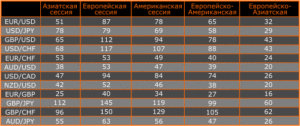
Asian session (Tokyo) 00.00-09.00 UTC
Forex trading activity in Asia is centered around a few large regional financial centers. During the Asian trading session, the largest number of transactions are made in Tokyo, followed by Hong Kong, Shanghai and Singapore.
Despite the fact that in recent years the role of the Japanese Central Bank in the foreign exchange market has decreased, Tokyo remains one of the world’s leading financial centers. When trading opens in Tokyo every morning, many bidders use their momentum to gauge market performance and determine their trading tactics.
Often, trading in Tokyo is quite thin. Large investment banks and hedge funds often use the Asian session to move the market towards important stops and option barriers.
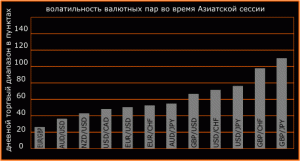
For risk-tolerant traders, currency pairs such as USD/JPY, GBP/CHF and GBP/JPY are suitable for trading. A large trading range for these currency pairs (over 80 pips on average) can provide good opportunities for short-term trades. Most of the transactions on the USD/JPY pair during the Asian session are carried out by investment banks and institutional investors who hold large dollar-denominated assets.
The first place here belongs to the Japanese Central Bank, which owns US government bonds worth more than 800 billion US dollars. Transactions in the Japanese stock and bond markets also affect the supply and demand for USD/JPY. Finally, major Japanese exporters are known for often selling their dollar profits for yen during the Asian session, which provides additional moves for the pair.
The volatility of the GBP/CHF and GBP/JPY pound crosses is due to the fact that during the Japanese trading session, central banks and major players begin to change the scale of transactions on the eve of the opening of trading in Europe. At the bottom of the rating are the AUD/JPY, GBP/USD and USD/CHF pairs. They are suitable for players who are afraid of risks. The moderate volatility of these pairs will attract the interest of cautious traders.
European session 7.00-16.00 UTC
London is the largest and most important dealing centre in the world. The volume of trading in shares in London, according to the Bank for International Settlements, is more than 30% of the world. Most of the trading terminals of large banks are located in London and due to the high liquidity and efficiency of the market, many investors prefer to work during the hours of the European session. A large number of participants and significant volumes of transactions make the London foreign exchange market the most volatile of all. The table below shows the volatility rating for the major currency pairs during the European session. As you can see, of the 12 major pairs, the trading range for half is more than 80 points.
The largest average ranges are typical for GBP/JPY, GBP/CHF – 140 and 146 points, respectively. The GBP/JPY and GBP/CHF pairs are suitable for high-risk trades. 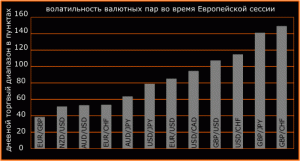 High volatility reflects the peak of daily trading activity, as large traders complete the daily cycle of restructuring their assets at this time. The European session partially overlaps the Asian and American sessions.
High volatility reflects the peak of daily trading activity, as large traders complete the daily cycle of restructuring their assets at this time. The European session partially overlaps the Asian and American sessions.
As soon as large banks and investment investors complete the repositioning of their portfolios, they need to convert European assets into dollar-denominated assets in anticipation of the opening of trading in the United States. The combination of these two restructurings during trading in Europe explains the high volatility during this period of time. For risky traders, other currency pairs may be suitable at this time: EUR/USD, USD/CAD, GBP/USD and USD/CHF.
For all these pairs, the average range exceeds 80 points. High volatility often offers good opportunities to enter the market. As noted above, activity in European currencies and the dollar is growing, as large bidders shuffle their portfolios before the opening of the American session. For more cautious traders, it is recommended to work with NZD/USD, AUD/USD, EUR/CHF and AUD/JPY pairs. For them, the average range is about 50 points. These currency pairs, in addition to potential profits, can provide a good interest income. They allow traders to make decisions based on fundamental economic factors. In addition, trading on them has a lower probability of losses caused by internal speculative activity.
American session from 13.30 to 20.00 UTC.
New York is the second largest market, accounting for 19% of the total turnover in the Forex market. The trading period in New York is a period of various dark deeds and intrigues of major players, since from the second half of the day in the United States to the opening of trading in Japan, market activity is declining, which favors dubious operations. Most trades in the American session are executed between 13.30 and 17.00 (UTC). This period is characterized by the largest daily liquidity, as European players are still in the market. For risky traders, such pairs as GBP/USD, USD/CHF, GBP/JPY, and GBP/CHF will be of interest during trading in the United States. 
As can be seen from the table, their average range during the American session exceeds 100 points. The activity on these pairs is the greatest, as it is directly related to the US dollar.
When the U.S. stock market and bond markets are open, foreign investors often convert their currencies such as the yen, franc, and pound into U.S. dollars in order to be able to place them in said markets. When market hours “cross”, GBP/JPY and GBP/CHF have the largest ranges.
Most currencies on Forex are quoted in US dollars and are primarily traded against “green” ones. In the case of GBP/JPY, in order for the British pound to be converted into the Japanese yen, it is often traded first against the dollar, then against the yen. Thus, a trade on the GBP/JPY pair consists of two different currency trades GBP/USD and USD/JPY, and its high volatility is determined by the correlation of these two currency pairs. Since GBP/USD and USD/JPY have a negative correlation (i.e. move in opposite directions), the volatility of GBP/JPY increases. The same can be said about the GBP/CHF pair, whose volatility is even greater.
Trading currency pairs with high volatility can be profitable, but it is also important to remember that it carries with it great risks. Risky traders constantly have to revise their tactics, since sharp movements in the market often lead to the triggering of stop losses and incur losses on long-term strategies.
More cautious traders can choose pairs such as USD/JPY, EUR/USD and USD/CAD. These pairs are characterized by fairly wide session ranges, and less risk than the first four. They are highly liquid, allowing traders to keep profits and cut losses. The moderate volatility of these pairs also favors traders working on long-term strategies.
Overlap of the European and American sessions 13.30-16.00 UTC
At this time, activity in the market reaches its greatest scope, since at this time trading takes place on the two largest world markets at the same time. At this time, 70% of all transactions in the foreign exchange market for the European session and 80% of all transactions for the American session are accounted for. For volatility lovers and those who are bored of looking at the screen all day, it is best to choose this time for trading.
Overlapping Asian and European sessions. 07.00 –09.00 UTC
The least active period of time in the market. During these two hours, trading is very thin, and this period can be used by traders who are afraid of risks for their positioning at the opening of trading in Europe. 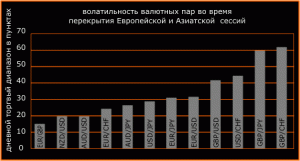
The article is written using data from the book by analyst Katie Liin “Day Trading in the Foreign Exchange Market”
Strategically important moments of the trading day
(UTC/GMT) winter time is indicated in parentheses
SUNDAY 21 :00 (22:00) – TRADING BEGINS (note: in European DCs) post-Friday pullback, as a rule, it is better to be at the terminal
21:00 (22:00) – the beginning of the trading session in Wellington (N. Zealand) nothing special happens, sluggish trading
23:00 (24:00) – the beginning of the trading session in Sydney, trading is slowly gaining momentum due to the opening in an hour Tokyo in front of Tokyo boldly two bets in different directions with profits of 5 – 10 points
24:00 – the opening of Tokyo, trade is gaining momentum, it is worth considering the fact that there are corporate relations between Asian investors, they act smoothly and clearly, if they go in the same direction – then all at once
01:00 – the opening of Singapore, the dynamics is growing due to the approaching opening of two giant exchanges – in Shanghai and Hong Kong, before the Chinese session, as a rule, the euro declines until the opening of Shanghai and Hong Kong,
01:00 – 01:30 – Before the Chinese session, the euro most often goes down, but there are exceptions… Exercise caution
01:30 – the opening of Shanghai and Hong Kong, usually begins large-scale trade, trades the entire Asia-Pacific region.
A separate word about China
(two exchanges Shanghai and Hong Kong – the opening hours are the same).
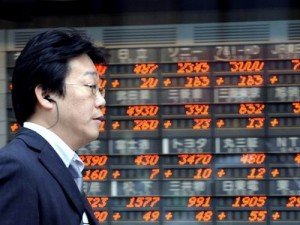 The structure of Chinese exports is as follows: most of the goods are paid for in dollars, so it can be assumed that China has no need to buy dollars, the Chinese have nowhere to put them anyway. Therefore, most often in the Chinese session, the growth of EUR/USD. China is one of the countries with the largest gold – foreign exchange reserves on the planet, so one hint that China will get rid of some of the dollars is enough to panic and the growth of the euro. In addition, China is the largest creditor of the United States. Apparently, while China is getting rid of the dollar – at a loss. Threats to the diversification of foreign exchange reserves are most often speculative in nature. FOLLOW THE CHINESE, THEIR PERFORMANCES AND ACTIONS. If the Chinese massively buy a dollar, the whole day will look like a casino. If they buy euros, everything is predictable.
The structure of Chinese exports is as follows: most of the goods are paid for in dollars, so it can be assumed that China has no need to buy dollars, the Chinese have nowhere to put them anyway. Therefore, most often in the Chinese session, the growth of EUR/USD. China is one of the countries with the largest gold – foreign exchange reserves on the planet, so one hint that China will get rid of some of the dollars is enough to panic and the growth of the euro. In addition, China is the largest creditor of the United States. Apparently, while China is getting rid of the dollar – at a loss. Threats to the diversification of foreign exchange reserves are most often speculative in nature. FOLLOW THE CHINESE, THEIR PERFORMANCES AND ACTIONS. If the Chinese massively buy a dollar, the whole day will look like a casino. If they buy euros, everything is predictable.
01:30 – 02:30 – the euro most often rises within an hour
02:30 – 06:00 – transactions can be multidirectional on EURUSD, Asian exporters convert part of their profits into both dollars and euros
06:00 – Tokyo closes, if the Euro has been actively falling up to this point, then after the closure of Tokyo, the Chinese are driving the Euro up
06:00 – 07:00 – relatively speaking – the “Chinese hour” on the stock exchange, the Chinese and Singapore do what they want. At this time, the Euro most often rises. Asia is a huge commercial and industrial region, an abundance of high-quality and inexpensive goods, gigantic finances in circulation; Accordingly, there are a lot of rates on the exchanges. Therefore, the bets made at the opening of LONDON should be monitored after the exit from the trade of the Asian region.
07:00 (08:00) – opening of London and European stock exchanges, according to observations, more sales of the Euro prevail in the first hours
09:00 – the closing of Singapore and the end of the Asian session – almost immediately or within an hour, a breakthrough in the euro, a change in trend (most often) to
11:30 09:00 – a jerk on the euro immediately or a little late, no one bothers the Europeans, as a rule, Asian stops are knocked down
10:00 – 10:30 – often there is a change in the trend in the European session;
11:00 – 13:00 – completion of trade turnover on oil trading floors, Dubai, Qatar, Emirates, etc., it seems that they also do not need dollars, since oil trade goes for dollars, most often the growth of the Euro; it is worth noting the last hours of operation of the sites of the Middle East. The oil region, the exchanges do not work for long, but the volumes are not small, there are plenty of petrodollars, it can be assumed that there is no reason for them to buy dollars.
13:00-13:30 (14:00-14:30) – it’s time to close all unreliable positions due to the upcoming American lawlessness, or lock up from losses, the Euro often falls in front of America;
BETWEEN 13:00 and 13:30 (14:00 and 14:30) UTC/GMT – PLANNED CONFUSION AND EXCITEMENT before the opening of THREE MAJOR EXCHANGES – NEW YORK, TORONTO AND CHICAGO. IT’S TIME TO SECURE YOUR POSITION! 13:30 – the opening of the stock exchanges of America and Canada, well, we must not forget that Europe has not yet left the trade, at this time the largest trading begins, it is very difficult to predict anything, do not even try to interpret the news, pure speculation, trends are formed quickly;
13:30 (14:30) – AMERICANS BEGIN TO FLATTEN AND STARE EVERYONE IN A ROW! IT IS UNREALISTIC TO PREDICT THE DIRECTION OF THE TREND, BUT BY THE TIME LONDON, ZURICH AND FRANKFURT CLOSE, THE FORMED TREND OFTEN CHANGES TO THE OPPOSITE.
15:30 (16:30) – the European session closes, the trend for the Euro changes sharply very often
19:00-20:00 (20:00-21:00) – the last hour of the American session, the existing trend often resumes until 21:00 – 21:30 The first and last hour of operation of any exchange is the time of maximum activity of institutional clients with huge money and very large funds. This does not mean that they are messing around the whole session, they are analyzing the situation. But transactions fall mainly on these hours, which makes it possible to predict price movements at the opening and closing of large exchanges. Place bets before the opening of exchanges (in 1 – 2 minutes)
In the first hours of the night, EUR/USD rolls back more often almost before the opening of TOKYO, as a rule, if the price went up to 21-22 UTC.
On FRIDAY, there is a massive knocking down of stops.
FRIDAY at 21:00 GMT/UTC – trading stops
A few tips for traders
Winter time is indicated in parentheses
13:25 – 13:29 (14:25-14:29) UTC – before the opening of the American sites – boldly two bets in both directions with a profit of 10 points (this is the minimum) and two more bets in both directions in order to take 150 – 180 points in one direction. The second bet with a small profit in anticipation of a return or closes on a pullback with a minus. Naturally, there should be a positive difference between the two orders. This is only done if you do not know the direction. If the chart is at the lower border of the corridor indicated by the extreme values of support and resistance, then buy, if the upper one is selling. In the middle is a bet in different directions with profits of 10 points or more, depending on your desire to take risks.
With an iron hand, you close the minus, there should be no question of any greed, you are content with small and small. Take a little, but often.
The exchange is not very loyal to investors, based on the knowledge of this fact, it is necessary to learn a strict rule – all news regarding events on the exchanges is 90% misinformation, and no one knows how to find 10% of the truth! A consortium of world banks, very skillfully conducts business and does not catch moose. You can never say what the market will decide to react to.
On Wednesday and Friday, do not work in large lots. Very strong jerks in both directions. It would be more accurate to say, never work with a large lot with leverage. There will be a couple or three million in circulation in a few years, you will work in large lots without leverage, and as long as there is leverage, there is a serious risk of quick liquidation of the deposit. You can lose money in almost a couple of minutes.
If it is not possible to look after the trading terminal, make only meager bets or not at all.
Trading is about hunting for money. And the best hunter is the one who patiently sits in ambush and shoots only at point-blank range and for sure.
Never work tired! You can simply fall asleep while trading or stupidly make mistakes. Laptop owners, by the way, sometimes involuntarily touch the touchpad from fatigue and if the cursor is hovered over buy or sell, an order is placed or a position is closed with a minus … (it is better to close the touchpad with a cardboard)
the maximum drawdown directly depends on the lot being traded; i.e. when trading with a lot of 0.1, the price must go to 20 figures (2000 points) to completely drain the deposit; with a lot, say, 0.5 is enough to drain 4 figures (400 points); in any case, the price departure from your bet by 200 points can be considered as an error in determining the trend, respectively, at low rates, the loss is not significant, it will not lead to the drain of the deposit Be especially careful about all sorts of indicators and trading robots; if you are a cool programmer and are able to deal with the program code – then please, you can experiment on a demo or with meager amounts; In real life, it is better to be careful, especially with serious money. The surest way to make money on forex is a gradual increase in the deposit, in small lots, without losses, without drawdowns. Note that Karl Marx recommended increasing capital in small doses!
Absolutely always use the safe lot rule: divide the deposit by 20,000, what will happen as a result is the law for execution, including when opening in both directions. When opening in both directions, the “buy” is lower than the “sell” by 6 – 10 points, a pending order is used. Wherever the course moves, the pose is in the black. Refer to the “Forex Orders” table on the main page.
If everyone sells a lot, then wait for the reverse movement of the rate and vice versa. If the positions are equal, two bets in different directions with a small take profit. Increase lots only from what you earn, do not replenish the deposit. This is due to the fact that it is psychologically impossible to immediately adjust to amounts that are many times larger than usual; secondly, trends are always weekly, with the exception of 5, a maximum of 10 percent of the total; That is, if it is ascending, then all week, etc., well, of course – do not go against the trend, the market cannot be deceived, it is better to stay on friendly terms with it.
Most often, the rate turns to where a larger number of stop losses will gather, then the rate returns to its theoretical value again, make friends with technical analysis, look for points where the rate will definitely return, as a rule, these are the highs or lows laid down at the regional session, at the next session the rate may return with a difference of 10 – 15 points (-), or 40 – 45 points (+) Technical analysis assumes, And the fundamental one has. Even if everything is fine on the charts, and everything is going according to your forecast, turn on the news more often: if a war has started somewhere again, there will be jumps and gaps During trading, keep a mobile terminal in reserve. It is desirable to have an inexpensive communicator with a mobile MT4 installed.
There are very unpleasant moments if the computer hangs or the light disappears.
Top 10 Binary Options Brokers
Брокер
Информация
Бонус
Регуляция
Открыть счёт
Инструменты:
Доходность :
Демо счет: No
Мин. депозит:
Перейти
Читать обзор
Инструменты:
Доходность :
Демо счет: No
Мин. депозит:
Перейти
Читать обзор
Инструменты:
Доходность :
Демо счет: No
Мин. депозит:
Перейти
Читать обзор
Инструменты:
Доходность :
Демо счет: No
Мин. депозит:
Перейти
Читать обзор
Инструменты:
Доходность :
Демо счет: No
Мин. депозит:
Перейти
Читать обзор
Инструменты:
Доходность :
Демо счет: No
Мин. депозит:
Перейти
Читать обзор
Инструменты:
Доходность :
Демо счет: No
Мин. депозит:
Перейти
Читать обзор
Инструменты:
Доходность :
Демо счет: No
Мин. депозит:
Перейти
Читать обзор
Инструменты:
Доходность :
Демо счет: No
Мин. депозит:
Перейти
Читать обзор
Инструменты:
Доходность :
Демо счет: No
Мин. депозит:
Перейти
Читать обзор


